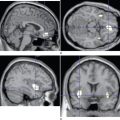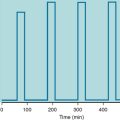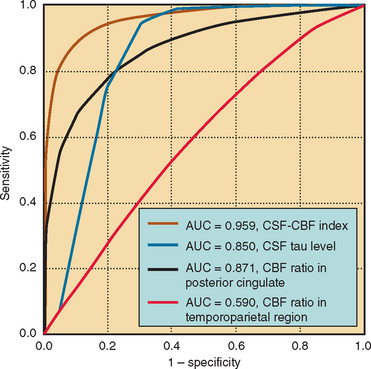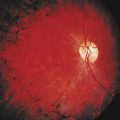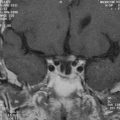CHAPTER 26 AUDITORY SYSTEM DISORDERS
Hearing loss can be defined as an increase in the threshold of sound perception. Understanding speech and the general world around us depends on the accurate perception and processing of complex, multifrequency sounds. There are multiple areas along the auditory pathway for pathology to occur that can cause distorted, inefficient, or unperceived sound, resulting in hearing loss. Hearing loss affects nearly 28 million Americans, including 30% of adults over the age of 65 and 50% over the age of 85. Hearing loss is one of the most common chronic illnesses, and as the population ages and lives longer, it will increasingly affect the morbidity and quality of life of patients. Hearing loss is not just a disorder of adults. It also significantly affects children and their daily lives, as well as the lives of their parents and caregivers. Otitis media can cause a conductive hearing loss due to fluid accumulation that can take months to resolve. Otitis media is the most common reason for a child to visit the pediatrician. By 3 years of age, three of every four children will have had at least one episode of otitis media. This has a significant financial impact on the health care system, in addition to the financial impact on parents, who lose income when they miss work to care for their sick children. Children can also be afflicted with congenital causes of hearing loss; two or three of every 1000 children born today will be either deaf or hard of hearing.
SENSORINEURAL HEARING LOSS
Sensorineural hearing loss is caused by damage to the cochlear sensory epithelium or, less commonly, the peripheral auditory neurons. The type of hearing loss a patient has can be quite different depending on whether the cochlea or the auditory nerve fibers are involved. When cochlear hair cell loss is the main reason for hearing difficulties, it often manifests as a sound threshold shift only. When the lesion involves the auditory nerve, or is called retrocochlear, a patient often has significant sound distortion that manifests as difficulty with word discrimination out of proportion to the associated hearing loss. On bedside evaluation, the Rinne test is positive, and if the hearing loss is unilateral, the Weber test lateralizes away from the side with the hearing loss, or toward the good ear. Sensorineural hearing loss is a challenge to physicians, as it progresses with age and causes significant reductions in quality of life and there are no treatments to reverse its effects, other than sound amplification with the use of hearing aids or direct auditory nerve stimulation via cochlear implantation.
CAUSES OF CONDUCTIVE HEARING LOSS
Cholesteatoma
Cholesteatoma is normally associated with the middle ear and mastoid, but it can occasionally occur in the external auditory canal. Through inflammation and associated infection, it can cause a conductive hearing loss. Cholesteatomas of the external canal are usually unilateral and have associated symptoms of otalgia and otorrhea. On examination, there is narrowing or occlusion of the external auditory canal, abundant keratin debris, and sometimes granulation tissue. Treatment includes resolution of the external otitis infection with topical antibiotic eardrops and occasional systemic antibiotics, followed by surgical debridement and excision of the cholesteatoma.1
External Auditory Canal Tumors
Tumors of the external auditory canal, benign or malignant, can cause a conductive hearing loss. The two most common benign bony tumors are exostoses and osteomas.1 Exostoses are broad-based lesions that are often multiple and bilateral. Patients usually give a long history of cold water exposure, such as swimming, diving, or surfing. Exostoses are found in the medial portion of the bony external auditory canal near the annulus and often along the tympanomastoid and tympanosquamous suture lines. Osteomas are solitary and unilateral and are not associated with any significant history such as that of patients with exostosis. They are found in the lateral portion of the external auditory canal at the bony-cartilaginous junction. Treatment of exostoses and osteomas is based on symptoms, as they are benign lesions with no known malignant conversion. Chronic or recurrent acute otitis externa is the most common reason patients undergo surgical excision. Care must be taken not to injure the mastoid segment of the facial nerve when removing these lesions, particularly when operating in the posteromedial external auditory canal. The most common malignant tumor of the external auditory canal is squamous cell cancer. Fortunately, these are rare head and neck tumors. They can arise from anywhere within the external auditory canal, and patients often have symptoms of otorrhea, otalgia, and occasionally hearing loss. Treatment is surgical excision with postoperative chemoradiation therapy depending on the stage of the tumor.
External Auditory Canal Stenosis or Absence
A rare cause of conductive hearing loss is stenosis or absence of the external auditory canal, as in congenital aural atresia. The incidence of aural atresia is 1 in 10,000 to 20,000 births.2 Aural atresia is usually associated with a large conductive hearing loss or air-bone gap, assuming that the cochlear function is normal. Varying degrees of external ear malformations (microtia), temporal bone atresia, ossicular deformities, and facial nerve anomalies are seen. Surgical treatment to repair the external ear, external auditory canal, and middle ear abnormalities can restore hearing to normal levels in favorable candidates.
Tympanic Membrane
Pathology of the tympanic membrane includes perforations, atelectasis, and tympanosclerosis. Aside from its role in protecting the middle ear, the tympanic membrane is critical in receiving sound waves and efficiently transmitting them through the ossicular chain to the endolymph of the cochlea. Any pathological process that compromises the mobility or efficiency of the tympanic membrane results in a conductive hearing loss. Tympanic membrane perforations can be caused by acute and chronic infections, head trauma, or iatrogenic causes, such as after tympanostomy tube extrusion. Tympanostomy tube placement is common in infants with otitis media and is one of the most common surgical procedures performed today. The reported rate of tympanic membrane perforation depends on the type of tube placed; however, routine grommet-type tubes have a 1% to 3% incidence.3 Most perforations from tympanostomy tubes are small, causing a 10-dB hearing loss or less, and usually heal with time. However, larger perforations and total perforations of the tympanic membrane, usually seen in patients with a history of chronic otitis media, can result in a significant conductive hearing loss of 30dB or more. A thin, atrophic, atelectatic tympanic membrane can also cause a conductive hearing loss, particularly if there is associated ossicular erosion. A retracted, atelectatic tympanic membrane is caused by eustachian tube dysfunction and the resultant chronic negative middle ear pressure. Hearing loss can be further affected in these patients by chronic middle ear fluid. Initial treatments consist of tympanostomy tube placement, tympanoplasty, and medical therapy, including decongestants and nasal steroid sprays. A common finding on otoscopy during routine physical examination is tympanosclerosis, a white discoloration of the tympanic membrane. Tympanosclerosis can be due to a prior history of tympanostomy tube placement and/or an associated history of otitis media. Unless the tympanic membrane involvement is particularly severe, it is rare for tympanosclerosis to cause an appreciable conductive hearing loss.
The ratio of the tympanic membrane area to the stapes footplate area results in an 18-fold amplification of sound under normal physiological conditions.4 Any disruption or fixation of the ossicular movements impairs this efficient sound transmission. Therefore, any abnormalities of the ossicular chain manifest as a conductive hearing loss. Otosclerosis is a common cause of conductive hearing loss due to stapes footplate fixation. Otosclerosis is a disease of bone limited to the otic capsule. Classically, it causes a conductive hearing loss, but it must be mentioned that otosclerosis can also affect the cochlea, causing a mixed or even a purely sensorineural hearing loss. It is inherited in an autosomal dominant fashion with incomplete penetrance and is more often seen in white populations at a histological incidence of 7% to 10%. Only approximately 10% of patients with histological evidence of otosclerosis present with clinical symptoms.5 Two thirds of patients with otosclerosis are women. The disorder is often bilateral and classically manifests in the third and fourth decades of life as a conductive hearing loss. Otosclerosis in women has always been believed to worsen during pregnancy; however, clinical data have brought into question that premise.6 Treatment is often curative with stapedotomy or stapedectomy surgery.
Middle ear and mastoid cholesteatoma is defined as an accumulation of keratin and desquamated debris from the squamous epithelial lining of the external auditory canal and lateral surface of the tympanic membrane. There are two types: congenital and acquired. Congenital cholesteatoma is an anteriorly based mass believed to be an embryological remnant. The more common type is the acquired cholesteatoma that results from otitis media. Squamous epithelium migrates into the middle ear and mastoid. Of the acquired type, cholesteatoma can occur in the setting of a tympanic membrane perforation or from chronic otitis media due to eustachian tube dysfunction causing persistent negative pressure and tympanic membrane retraction. Cholesteatoma manifests as a middle ear mass, often in close approximation to the ossicles, with or without bony erosion, and patients present with a conductive hearing loss. Other symptoms commonly include chronic otorrhea and rarely vertigo and facial nerve paresis or palsy. Treatment consists of treating any infection first and then surgical removal of the cholesteatoma with ossicular reconstruction if warranted. Ossicular reconstruction is sometimes delayed 6 to 12 months, during which time patients are observed for any signs of recurrence or recidivism. If the posterior external auditory canal wall is left intact, recurrence rates are slightly higher at 5% to 27% versus 2% to 10% when the posterior canal wall is removed.7 When treating cholesteatoma, the first priority is to create a dry, safe ear, as infectious complications of a cholesteatoma can have significant morbidity, such as meningitis and brain abscesses. Correcting the conductive hearing loss is a second priority only after antimicrobial and surgical treatments have been successful.
Otitis Media
The most common cause of hearing loss in children is due to otitis media. Approximately 85% of children have at least one episode of acute otitis media. A decade ago, otitis media was estimated to cost the health care industry more than $5 billion annually.8 Factors that predispose children to otitis media include bottle feeding, crowded living conditions, day care, smoking at home, hereditary influences, and craniofacial abnormalities, such as cleft palate. Early treatment for children with chronic otitis media is critical to proper development. Lack of intervention can result in abnormal development of cognition, language, and general communicative skills.9
Otitis media with effusion or serous otitis media causes a conductive hearing loss by preventing normal mobility of the tympanic membrane as seen on pneumatic otoscopy and tympanometry examination. Audiometry in children with otitis media with effusion reveals an average air-conduction threshold of 28dB.10 Guidelines from the Agency for Health Care Policy and Research (now called the Agency for Healthcare Research and Quality [AHRQ]) recommend treatment for chronic otitis media with effusion for any conductive hearing loss greater than 20dB.11 Treatment for hearing loss from otitis media with effusion usually consists of tympanostomy tube placement. Antibiotic prophylaxis is generally not recommended due to the risk of promoting antimicrobial resistance. Other medications, such as antihistamines, decongestants, and corticosteroids, have not proved to be effective in clinical studies.
Superior Canal Dehiscence Syndrome
Pathology of the inner ear has always been associated with sensorineural hearing loss. However, in 1998 superior canal dehiscence syndrome was described.12 In this syndrome, the bone overlying the semicircular canal on the floor of the middle cranial fossa is found to be dehiscent on computed tomography. Signs and symptoms may include vertical-torsional eye movements in response to loud sounds or middle ear pressure changes, autophony, and chronic disequilibrium, all of which can be disabling when severe.13,14 The symptoms and signs in this syndrome have been described as the dehiscence being a third window into the inner ear, with the other two being the oval and round windows. Intracranial pressure differences can exert pressure on this third window, creating the characteristic signs and symptoms. Other symptoms of this syndrome have been air-bone gaps and suprathreshold bone conduction hearing levels believed to be due to sound wave escape through the dehiscent superior semicircular canal. The dehiscence provides a low resistance alternative pathway for sound waves, thereby increasing air-conduction thresholds. There are several reports of patients undergoing unsuccessful stapes surgery for a conductive hearing loss only to be later diagnosed with superior canal dehiscence15 (personal communication, Michael Teixido, MD, Wilmington, DE, 2005). There have also been cases of patients having air-bone threshold gaps on audiometry with enlarged vestibular aqueducts, a possible alternative site contributing to the third mobile window theory. Treatment for superior canal dehiscence is surgical in those patients with severe debilitating symptoms. Surgical approaches include middle fossa craniotomy or transmastoid with varying success rates16 (personal communication, Michael Teixido, MD, Wilmington, DE, 2005).
CAUSES OF SENSORINEURAL HEARING LOSS
Age-related hearing loss, or presbycusis, is a common diagnosis in the aging population. By strict definition, presbycusis is hearing loss specifically caused by aging. However, it has been nearly impossible to filter out other causes that can contribute to age-related hearing loss, such as genetic factors, accumulated noise injury, acoustic trauma, and vascular and metabolic factors. Strictly speaking, there are four main physiological mechanisms that contribute to presbycusis. There can be loss of cochlear hair cells, predominantly in the high-frequency range, and the speech discrimination is usually preserved. There can be auditory neuronal loss that results in a generalized loss in all pure-tone averages but a disproportionate impairment in speech discrimination. The stria vascularis, which produces the endocochlear potential of the endolymph, can atrophy, and the result is a flat hearing loss on pure-tone averages with preservation of speech discrimination. And last, the basilar membrane can stiffen with age, which results in less sensitivity to sound waves, causing a cochlear conductive hearing loss.17 Cochlear implantation is a technological advance that can restore hearing to those adults with severe-profound hearing loss who have limited benefit from hearing aids. Success rates are high and can dramatically improve patients’ quality of life, particular the elderly.
Noise-induced Hearing Loss
Noise-induced hearing loss is one of the most common causes of adult hearing impairment in the United States, second only to presbycusis. It is estimated that over 10 million people have noise-induced hearing loss.18 Noise exposure can be in the workplace, at home, or during recreational activities. Even the ambient noise level that Americans are exposed to on a daily basis is significantly higher now than it was one or two centuries ago prior to modern industrialization, which probably exacerbates noise-induced hearing loss as the population ages. Noise exposure causes a sensorineural hearing loss that affects both the cochlear hair cells and the auditory neurons. Most exposures result in what is called a temporary threshold shift that is reversible and recovers over a 24- to 48-hour period. Repeat exposures eventually result in a permanent threshold shift and subsequent hearing loss that can be documented by audiometry. Continuous noise exposure has been shown to be more damaging than intermittent noise exposure, due to limited recovery time during continuous exposure. A single episode of severe noise exposure or what is called acoustic trauma, if loud enough, can result in an immediate, permanent threshold shift. Noise damage to the cochlea typically affects the outer hair cells and is temporary; however, if the exposure persists, the outer hair cell damage becomes permanent and proceeds to affect the inner hair cells as well.19 The classic hearing loss seen on audiometry is in the 2-, 4-, and 6-kHz frequency ranges. An increase in the sensorineural hearing threshold at the 4-kHz frequency has been historically called the boilermakers notch and is classic for occupational noise-induced hearing loss.20 Only in the past few decades has noise-induced hearing loss been recognized as one of the most common causes of occupation-induced disability. As a result, noise exposure is now regulated by the Occupational Health and Safety Administration (OSHA). Current OSHA regulations require hearing protection for workers exposed to 90-dBA noise based on an 8-hour-per-day time-weighted average. Most industries require hearing conservation programs when noise levels are greater than or equal to 85dBA. Treatment of noise-induced hearing loss consists of early identification and prevention of harmful noise exposure to prevent further deterioration in hearing threshold levels.
Ototoxicity
Aminoglycoside antibiotics are potent medications against gram-negative infections, and all have been found to have ototoxic side effects. Because of their low cost, they are commonly used worldwide.21 Streptomycin, discovered in 1940, was the first aminoglycoside. It was originally used to treat tuberculosis and, with these early treatment trials, reports of ototoxicity surfaced. Streptomycin and gentamicin are generally more vestibulotoxic, whereas tobramycin, amikacin, and neomycin are more cochleotoxic. The cochleotoxic effects manifest with tinnitus and then proceed with damage to the outer hair cells in the basal turn of the cochlea, giving a high-frequency sensorineural hearing loss. This hearing loss is often believed to be irreversible, but some recovery of hearing has been seen weeks after cessation of therapy.22 The risk of ototoxicity with aminoglycoside use is believed to be 10% to 15%, and this is increased in combination with certain other medications, such as loop diuretics and cisplatin.23,24 Factors that increase the risk of aminoglycoside-induced ototoxicity include renal disease, prolonged duration of therapy, and elevated peak and/or trough levels on serum blood testing. Occasionally, the vestibulotoxic effects of aminoglycosides are used therapeutically, such as in patients with episodic vertigo from Meniere’s disease. When patients are refractory to conventional treatments, gentamicin can be administered topically into the middle ear space to induce a chemical labyrinthectomy and relieve the disabling vertigo many of these patients experience.
There are scant data on most other antibiotics in regard to hearing loss; however, there have been some reports of macrolide and vancomycin ototoxicities. The mechanism of macrolide-induced hearing loss is unknown, and the effects are generally reversible.25 Vancomycin-related ototoxicity has been more difficult to quantify due to multiple other medications and confounding comorbidities in the majority of patients receiving vancomycin therapy. The incidence of vancomycin ototoxicity has been estimated to be 3% and does not correlate to serum levels.26
The two most commonly implicated diuretic medications causing ototoxicity are furosemide and ethacrynic acid. Ototoxicity with these medications manifests as sensorineural hearing loss, as well as tinnitus and vertigo. These loop diuretics cause ototoxicity by injuring the stria vascularis, which is responsible for producing endolymph, and the endocochlear potential that allows for sound perception.27 The risk of sensorineural hearing loss caused by these medications has been reported to be approximately 1% to 6% and can be both temporary and permanent.28,29 Renal failure and rapid infusion can increase the ototoxic risks of these loop diuretics.
A well-known reversible cause of ototoxicity is treatment with salicylates and, less commonly, with nonsteroidal anti-inflammatory drugs. These medications are routinely prescribed for common problems such as arthritis. The mechanism is believed to be due to reduced cochlear blood flow and alterations of the outer hair cell motility.30 The effects are dose dependent and reverse with cessation of therapy.31 Tinnitus can be consistently reproduced at doses of 6 to 8g/day. Along with tinnitus, audiometric testing manifests a mild-to-moderate flat, bilateral sensorineural hearing loss that resolves in 48 to 72 hours after cessation of the medication.32 Other notable medications known for their ototoxic effects include the antimalarial medication quinine, which primarily causes transient hearing loss. Cisplatin, a common antineoplastic medication used to treat head and neck squamous cell cancers, is both ototoxic and nephrotoxic. The ototoxic effects are usually permanent and bilateral. At least some degree of hearing loss occurs in most treated patients. The effects are often dose dependent and affect the outer hair cells in the basal turn, yielding a high-frequency hearing loss.33
SUMMARY
Gates GA. Cost-effectiveness considerations in otitis media treatment. Otolaryngol Head Neck Surg. 1996;114:525.
Minor LB. Labyrinthine fistulae: pathobiology and management. Curr Opin Otolaryngol Head Neck Surg. 2003;11:340-346.
Mikulec AA, Poe DS, McKenna MJ. Operative management of superior semicircular canal dehiscence. Laryngoscope. 2005;115:501-507.
Riggs LC, Brummett RE, Guitjens SK, et al. Ototoxicity resulting from combined administration of cisplatin and gentamycin. Laryngoscope. 1996;106:401-406.
1 Tran LP, Grundfast KM, Selesnick SH. Benign lesions of the external auditory canal. Otol Clin North Am. 1996;5:807-825.
2 Jahrsdoefer RA. Congenital atresia of the ear. Laryngoscope. 1978;88(Suppl 13):1-46.
3 McLelland CA. Incidence of complications from use of tympanostomy tubes. Arch Otolaryngol Head Neck Surg. 1980;106:97.
4 Wever EG, Lawerence M. Physiological Acoustics. Princeton: Princeton University Press, 1954.
5 Morrison AW, Bundey SE. The inheritance of otosclerosis. J Laryngol Otol. 1970;84:921.
6 Lippy WH: Otosclerosis and pregnancy. Presented at the Triological Society Annual Meeting, May 15, 2005, Boca Raton, FL.
7 Karmaker S, et al. Cholesteatoma surgery: the individualized technique. Ann Otol Rhinol Laryngol. 1995;104:591.
8 Gates GA. Cost-effectiveness considerations in otitis media treatment. Otolaryngol Head Neck Surg. 1996;114:525.
9 Klein JO, et al. Otitis media with effusion during the first three years of life and development of speech and language. In: Lim DL, et al, editors. Recent Advances in Otitis Media With Effusion. Philadelphia: Mosby, 1983.
10 Fria TJ, et al. Hearing acuity of children with otitis media with effusion. Arch Otolaryngol Head Neck Surg. 1985;111:10.
11 Stool SE, et al. Otitis Media With Effusion in Young Children. Rockville, MD: Agency for Health Care Policy and Research, U.S. Public Health Service, U.S. Department of Health and Human Services, 1994. Clinical Practice Guideline Technical Report No. 12, AHCPR Publication No. 94–0622.
12 Minor LB, Solomon D, Zinreich JS, et al. Sound-and/or pressure-induced vertigo due to bone dehiscence of the superior semicircular canal. Arch Otolaryngol Head Neck Surg. 1998;124:249.
13 Minor LB. Superior canal dehiscence syndrome. Am J Otol. 2000;21:9-19.
14 Minor LB. Labyrinthine fistulae: pathobiology and management. Curr Opin Otolaryngol Head Neck Surg. 2003;11:340-346.
15 Minor LB. Dehiscence of bone overlying the superior canal as a cause of apparent conductive hearing loss. Otol Neurotol. 2003;24:270-278.
16 Mikulec AA, Poe DS, McKenna MJ. Operative management of superior semicircular canal dehiscence. Laryngoscope. 2005;115:501-507.
17 Schuknecht HF. Pathology of the Ear, 2nd ed. Philadelphia: Lea & Febiger, 1993.
18 Suter AH, Von Gierke HE. Noise and policy. Ear Hear. 1987;8:188.
19 Saunders JC, Cohen YE, Szymko YM. The structural and functional consequences of acoustic injury in the cochlea and peripheral auditory system: a five year update. J Acoust Soc Am. 1991;90:136.
20 Bunch CC. Nerve deafness of known pathology or etiology: the diagnosis of occupational or traumatic deafness; a historical an audiometric study. Laryngoscope. 1937;47:615.
21 Forge A, Schach J. Aminoglycoside antibiotics. Audiol Neurotol. 2000;5:3-22.
22 Matz GJ. Clinical perspectives on ototoxic drugs. Ann Otol Rhinol Laryngol Suppl. 1990;148:39.
23 Fee WE. Aminoglycoside ototoxicity in the human. Laryngoscope. 1980;90(Pt 2, Suppl 24):1-19.
24 Riggs LC, Brummett RE, Guitjens SK, et al. Ototoxicity resulting from combined administration of cisplatin and gentamycin. Laryngoscope. 1996;106:401-406.
25 Bizjak ED, Haug MT, Schilz RJ, et al. Intravenous azithromycin-induced ototoxicity. Pharmacotherapy. 1999;19:245-248.
26 Elting LS, Rubenstein EB, Kurtin D, et al. Mississippi mud in the 1990s. Risks and outcomes of vancomycin-associated toxicity in general oncology practice. Cancer. 1998;83:2597-2606.
27 Rybak LP. Pathophysiology of furosemide ototoxicity. J Otolaryngol. 1982;11:127.
28 Tuzel IJ. Comparison of adverse reactions to bumetanide and furosemide. J Clin Pharmacol. 1981;21:615.
29 Boston Collaborative Drug Surveillance Program. Druginduced deafness. JAMA. 1973;224:515.
30 Boettcher FA, Salvi RJ. Salicylate ototoxicity: review and synthesis. Am J Otolaryngol. 1991;12:33.
31 Jung TT, et al. Ototoxicity of salicylates, nonsteroidal anti-inflammatory drugs, and quinine. Otolaryngol Clin North Am. 1993;26:791.
32 Myers EN, Bernstein JN, Fostiropolous G. Salicylate ototoxicity. N Engl J Med. 1965;273:587.
33 Laurell G. Ototoxicity of the anticancer drug cisplatin. Clinical and experimental aspects. Scand Audiol Suppl. 1991;33:1-47.

